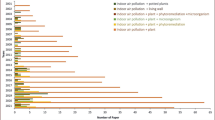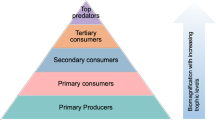Abstract
In this study, the environmental behavior of malodor pollutants (MPs) [including reduced sulfur compounds (RSCs)] and aromatic volatile organic compounds (AVOCs) were investigated around urban valley areas during several field campaigns (February through December 2006). The MPs measured in the study area include the RSCs (H2S, CH3SH, DMS, and DMDS), ammonia (NH3), and styrene (STY); the AVOCs include benzene (BEN), toluene (TOL), ethylbenzene (EB), m,p-xylene (MPX), and o-xylene (OX). The variation of most MP concentrations (except for DMDS) was found to be larger than that of AVOCs. It was found that STY (2,346 ± 4,867 ppbv) was the most dominant MP followed by NH3 (447 ± 285), CH3SH (16 ± 41), and the others (<8). The magnitude of AVOCs was found in the following descending order: TOL (1.4 ± 2.2 ppbv), EB (1.0 ± 2.1), MPX (0.9 ± 2.0), and the others (<0.8). The concentration levels of most MPs on industrial (I) and downwind (D) sites were up to an order of magnitude higher than those at non-industrial (N) and upwind (U) sites. For most AVOCs, the former was ~3 times higher than the latter. For malodor intensity in RSCs, CH3SH was the dominant contributor. The concentration difference in target compounds between the sites/periods is likely to be caused by the combined effects such as emission sources, geographical features (e.g., semi-closed topography), and meteorological conditions (e.g., wind directions) in and outside the urban valley.
Similar content being viewed by others
References
ATSDR (2005). Health Consultation, El Paso lower valley community, Juárez north wastewater treatment plant, El Paso, El Paso County, Texas/ Juárez, Chiihuahua, Mexico. Retrieved December 28, 2005, from US Department of Health and Human Services, Division of Health Assessment and Consultation, Atlanta, Georgia 30333.
Berresheim, H., Wine, P. H., & Davis, D. D. (1995). Sulfur in the atmosphere. In H. B. Singh (Ed.), Composition, chemistry, climate of the atmosphere (pp. 251–307). New York: Van Nostrand Reinhold.
Blaha, D., Bartlett, K., Czepiel, P., Harriss, R., & Crill, P. (1999). Natural and anthropogenic methane sources in New England. Atmospheric Environment, 33, 243–255. doi:10.1016/S1352-2310(98)00153-8.
Brasseur, G. P., Orlando, J. J., & Tyndall, G. S. (1999). Trace gas exchanges and biochemical cycles. In Atmospheric Chemistry and Global Change. New York: Oxford Univ. Press.
Derwent, R. G., Davies, T. J., Delaney, M., Dollard, G. J., Field, R. A., Dumitrean, P., et al. (2000). Analysis and interpretation of the continuous hourly monitoring data for 26 C2–C8 hydrocarbons at 12 United Kingdom sites during 1996. Atmospheric Environment, 34, 297–312.
Dincer, F., & Muezzinoglu, A. (2006). Chemical characterization of odors due to some industrial and urban facilities in Izmir, Turkey. Atmospheric Environment, 40, 4210–4219. doi:10.1016/j.atmosenv.2005.12.067.
Gurjar, B. R., van Aardenne, J. A., Lelieveld, J., & Mohan, M. (2004). Emission estimates and trends (1990–2000) for megacity Delhi and implications. Atmospheric Environment, 38, 5663–5681. doi:10.1016/j.atmosenv.2004.05.057.
Hewitt, C. N. (1999). Reactive hydrocarbons in the atmosphere. New York: Elsevier.
Hsieh, L.-L., Chang, C.-C., Sree, U., & Lo, J.-G. (2006). Determination of volatile organic compounds in indoor air of buildings in nuclear power plants, Taiwan. Water, Air, and Soil Pollution, 170, 107–121. doi:10.1007/s11270-006-2839-z.
Ito, A., Takahashi, I., Nagata, Y., Chiba, K., & Haraguchi, H. (2001). Spatial and temporal characteristics of urban atmospheric methane in Nagoya City, Japan: An assessment of the contribution from regional landfills. Atmospheric Environment, 35, 3137–3144. doi:10.1016/S1352-2310(00)00533-1.
Kim, K.-H. (2006). Emissions of reduced sulfur compounds (RSC) as a landfill gas (LFG): A comparative study of young and old landfill facilities. Atmospheric Environment, 40, 6567–6578. doi:10.1016/j.atmosenv.2006.05.063.
Kim, K.-H., Choi, Y.-J., Jeon, E.-C., & Sunwoo, Y. (2005). Characterization of malodorous sulfur compounds in landfill gas. Atmospheric Environment, 39, 1103–1112. doi:10.1016/j.atmosenv.2004.09.083.
Kim, K.-H., Jeon, E.-C., Choi, Y.-J., & Koo, Y.-S. (2006). The emission characteristics and the related malodor intensities of gaseous reduced sulfur compounds (RSC) in a large industrial complex. Atmospheric Environment, 40, 4478–4490. doi:10.1016/j.atmosenv.2006.04.026.
Kim, K.-H., Jeon, E.-C., Koo, Y.-S., Im, M.-S., & Youn, Y.-H. (2007). An on-line analysis of reduced sulfur gases in the ambient air surrounding a large industrial complex. Atmospheric Environment, 41, 3829–3840. doi:10.1016/j.atmosenv.2007.01.032.
Korean Ministry of Environment (2005). Annual Report of Ambient Air Quality in Korea, 2004.
Lin, C.-W. (2001). Hazardous air pollutant source emissions for a chemical fiber manufacturing facility in Taiwan. Water, Air, and Soil Pollution, 128, 321–337. doi:10.1023/A:1010396906332.
Liu, C., Xu, Z., Du, Y., & Guo, H. (2000). Analyses of volatile organic compounds concentrations and variation trends in the air of Changchun, the northeast of China. Atmospheric Environment, 34, 4459–4466. doi:10.1016/S1352-2310(00)00102-3.
Madronich, S. (2006). Chemical evolution of gaseous air pollutants down-wind of tropical megacities: Mexico City case study. Atmospheric Environment, 40, 6012–6018. doi:10.1016/j.atmosenv.2005.08.047.
Millet, D. B., Donahue, N. M., Pandis, S. N., Polidori, A., Stanier, C. O., Turpin, B. J., et al. (2005). Atmospheric volatile organic compound measurements during the Pittsburgh air quality study: Results, interpretation, and quantification of primary and secondary contributions. Journal of Geophysical Research, 10, 110, D07S07. doi:10.1029/2004JD004601.
Molina, L., & Molina, M. (2002). Air quality in the Mexico MegaCity: An integrated assessment. Dordrecht: Kluwer.
Muezzinoglu, A. (2003). A study of volatile organic sulfur emissions causing urban odors. Chemosphere, 51, 245–252. doi:10.1016/S0045-6535(02)00821-4.
Na, K., Kim, Y. P., Moon, K.-C., Moon, I., & Fung, K. (2001). Concentrations of volatile organic compounds in an industrial area of Korea. Atmospheric Environment, 35, 2747–2756. doi:10.1016/S1352-2310(00)00313-7.
Nagata, Y. (2003). Odor intensity and odor threshold value. Journal of Japan Air Cleaning Association, 41, 17–25.
National Institute of Environmental Research (2005). NIER Compendium of Methods for the Determination of Offensive Odor, 2005.
Shon, Z.-H., Kim, K.-H., Jeon, E.-C., Kim, M.-Y., Kim, Y.-K., & Song, S.-K. (2005). Photochemistry of reduced sulfur compounds in a landfill environment. Atmospheric Environment, 39, 4803–4814. doi:10.1016/j.atmosenv.2005.06.024.
Shon, Z.-H., & Kim, K.-H. (2006). Photochemical oxidation of reduced sulfur compounds in the atmosphere of Seoul metropolitan city. Chemosphere, 63, 1859–1869. doi:10.1016/j.chemosphere.2005.10.021.
Song, S.-K., Shon, Z.-H., Kim, K.-H., Kim, S. C., Kim, Y.-K., & Kim, J. K. (2007). Monitoring of atmospheric reduced sulfur compounds and their oxidation in two coastal landfill areas. Atmospheric Environment, 41, 974–988. doi:10.1016/j.atmosenv.2006.09.026.
Song, S.-K., Shon, Z.-H., Kim, K.-H., Kim, Y.-K., & Pal, R. (2008). Dispersion and photochemical oxidation of reduced sulfur compounds in and around a large industrial complex in Korea. Atmospheric Environment, 42, 4269–4279. doi:10.1016/j.atmosenv.2008.01.015.
Wang, L., Parker, D. B., Parnell, C. B., Lacey, R. E., & Shaw, B. W. (2006). Comparison of CALPUFF and ISCST3 models for predicting downwind odor and source emission rates. Atmospheric Environment, 40, 4663–4669. doi:10.1016/j.atmosenv.2006.04.043.
Warneke, C., McKeen, S. A., de Gouw, J. A., Goldan, P. D., Kuster, W. C., Holloway, J. S., et al. (2007). Determination of urban volatile organic compound emission ratios and comparison with an emissions database. Journal of Geophysical Research, 12, D10S47. doi:10.1029/2006JD007930.
Watts, S. F. (2000). The mass budgets of carbonyl sulfide, dimethyl sulfide, carbon disulfide and hydrogen sulfide - phytoplankton production in the surface ocean. Atmospheric Environment, 34, 761–799. doi:10.1016/S1352-2310(99)00342-8.
Wu, B. Z., Feng, T. Z., Sree, U., Chiu, K. H., & Lo, J. G. (2006). Sampling and analysis of volatile organics emitted from wastewater treatment plant and drain system of an industrial science park. Analytica Chimica Acta, 576, 100–111. doi:10.1016/j.aca.2006.03.057.
Author information
Authors and Affiliations
Corresponding author
Rights and permissions
About this article
Cite this article
Song, SK., Shon, ZH., Kim, YK. et al. Characteristics of malodor pollutants and aromatic VOCs around an urban valley in Korea. Environ Monit Assess 157, 259–275 (2009). https://doi.org/10.1007/s10661-008-0533-x
Received:
Accepted:
Published:
Issue Date:
DOI: https://doi.org/10.1007/s10661-008-0533-x




